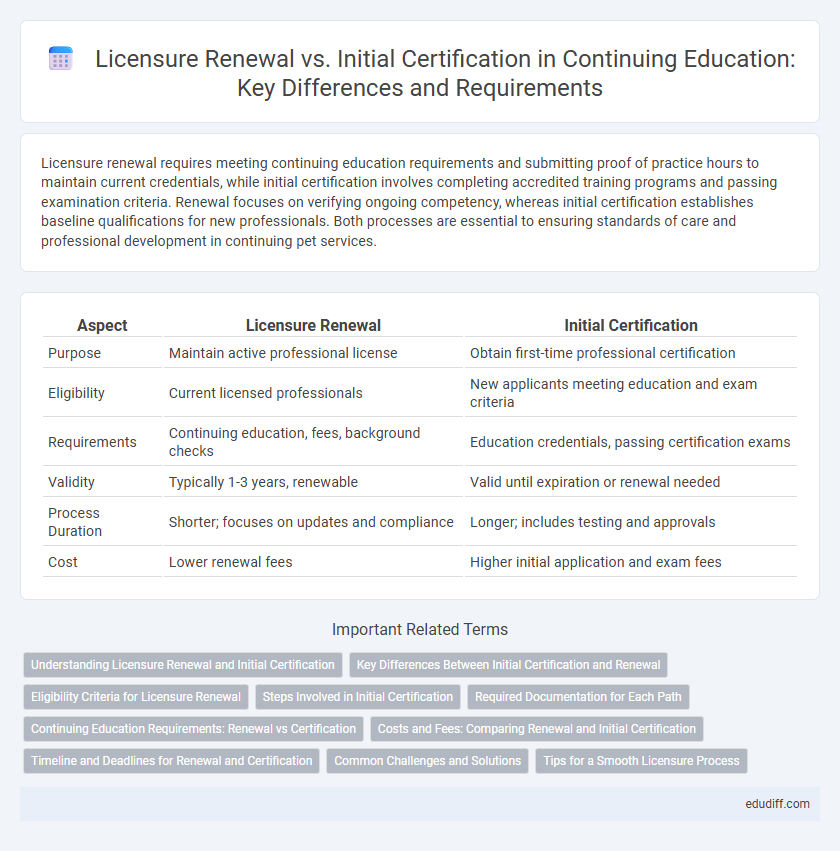Licensure renewal requires meeting continuing education requirements and submitting proof of practice hours to maintain current credentials, while initial certification involves completing accredited training programs and passing examination criteria. Renewal focuses on verifying ongoing competency, whereas initial certification establishes baseline qualifications for new professionals. Both processes are essential to ensuring standards of care and professional development in continuing pet services.
Table of Comparison
| Aspect | Licensure Renewal | Initial Certification |
|---|---|---|
| Purpose | Maintain active professional license | Obtain first-time professional certification |
| Eligibility | Current licensed professionals | New applicants meeting education and exam criteria |
| Requirements | Continuing education, fees, background checks | Education credentials, passing certification exams |
| Validity | Typically 1-3 years, renewable | Valid until expiration or renewal needed |
| Process Duration | Shorter; focuses on updates and compliance | Longer; includes testing and approvals |
| Cost | Lower renewal fees | Higher initial application and exam fees |
Understanding Licensure Renewal and Initial Certification
Licensure renewal involves the periodic process of maintaining an existing license by meeting specific continuing education and regulatory requirements, ensuring ongoing professional competence. Initial certification refers to the first-time achievement of credentials after successfully completing required education, examinations, and practical experience. Understanding the differences between these processes is critical for compliance and career progression in regulated professions.
Key Differences Between Initial Certification and Renewal
Initial certification requires meeting foundational eligibility criteria, such as completing accredited educational programs and passing standardized exams, while licensure renewal focuses on maintaining professional competence through continuing education and adherence to updated practice standards. Renewal often involves periodic verification of practice hours, submission of renewal applications, and compliance with regulatory body requirements, contrasting with the more rigorous testing and documentation needed for initial certification. These processes ensure both entry-level qualification and ongoing proficiency within the profession.
Eligibility Criteria for Licensure Renewal
Eligibility criteria for licensure renewal primarily require proof of active practice and completion of continuing education units (CEUs) within a specified renewal period, typically every two to three years. Applicants must also submit updated documentation demonstrating compliance with regulatory standards and may need to provide evidence of professional development or ongoing competency assessments. Failure to meet these requirements can result in suspension or revocation of the professional license.
Steps Involved in Initial Certification
Initial certification requires completing accredited education programs, passing comprehensive examinations, and submitting detailed application materials to the licensing board. Candidates must also fulfill specific clinical experience hours, often through supervised internships or residencies. Verification of credentials and successful background checks are integral to progressing toward initial licensure approval.
Required Documentation for Each Path
Licensure renewal typically requires submission of proof of completed continuing education units (CEUs), a current professional practice attestation, and updated background check results. Initial certification demands comprehensive documentation including official transcripts, standardized examination results, supervised practice verification, and application fees. Both paths mandate strict adherence to state-specific regulatory guidelines to ensure eligibility and maintain professional standards.
Continuing Education Requirements: Renewal vs Certification
Continuing education requirements for licensure renewal typically involve completing a specified number of approved credit hours within a set period to maintain professional credentials. Initial certification often requires passing an examination and meeting educational prerequisites without immediate continuing education mandates. Renewal emphasizes ongoing professional development to ensure practitioners stay current with industry standards and regulations.
Costs and Fees: Comparing Renewal and Initial Certification
Licensure renewal fees typically cost significantly less than initial certification due to reduced processing requirements and the absence of examination fees, with renewal averaging $50 to $150 versus initial certification fees ranging from $200 to $500. Initial certification expenses often include application fees, examination costs, and background checks, which are generally not required for renewal, making renewals more affordable for professionals maintaining their credentials. Understanding these cost differences aids candidates and license holders in better financial planning for certification maintenance versus initial credential acquisition.
Timeline and Deadlines for Renewal and Certification
Licensure renewal typically follows a fixed timeline established by regulatory boards, often requiring renewal every 1 to 3 years with strict deadlines to maintain active status. Initial certification deadlines vary by profession but generally mandate completion of education, exams, and application within a specified period, such as 6 months to 1 year after eligibility. Missing these renewal or certification deadlines can result in lapses, penalties, or the need to undergo additional training or testing.
Common Challenges and Solutions
Common challenges in licensure renewal versus initial certification include navigating updated regulatory requirements, managing documentation accuracy, and meeting continuing education mandates. Solutions involve utilizing digital tracking systems to streamline compliance, engaging in targeted professional development programs, and maintaining proactive communication with certifying bodies. Emphasizing these strategies helps minimize delays and ensures seamless certification transitions.
Tips for a Smooth Licensure Process
Prepare all required documents early, including proof of education, work experience, and continuing education credits to avoid delays in licensure renewal and initial certification. Stay updated with specific state board requirements and deadlines by regularly checking official websites or contacting licensing authorities. Utilize online application portals for faster processing and track your application status to promptly address any issues or additional requests.
Licensure Renewal vs Initial Certification Infographic

 edudiff.com
edudiff.com